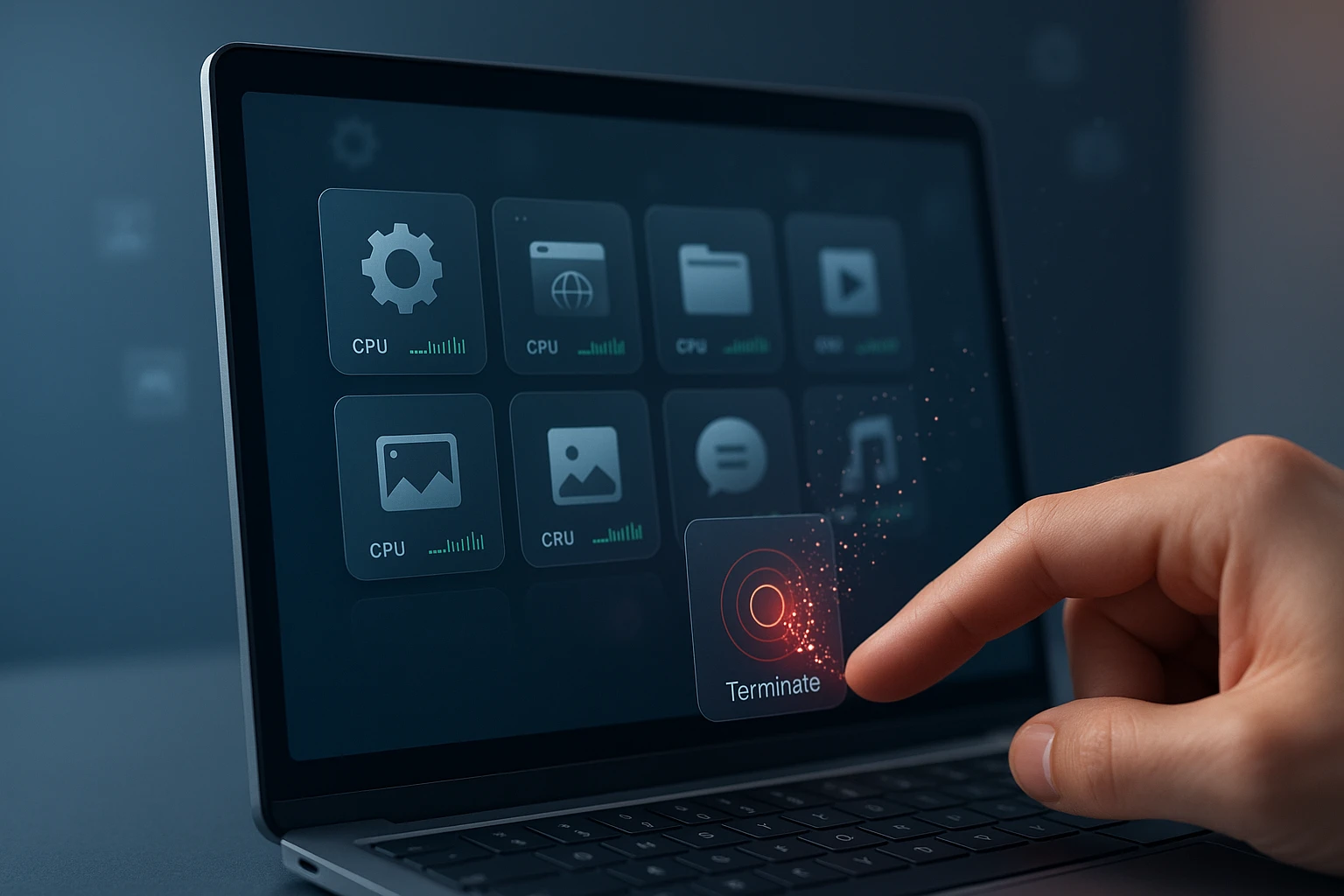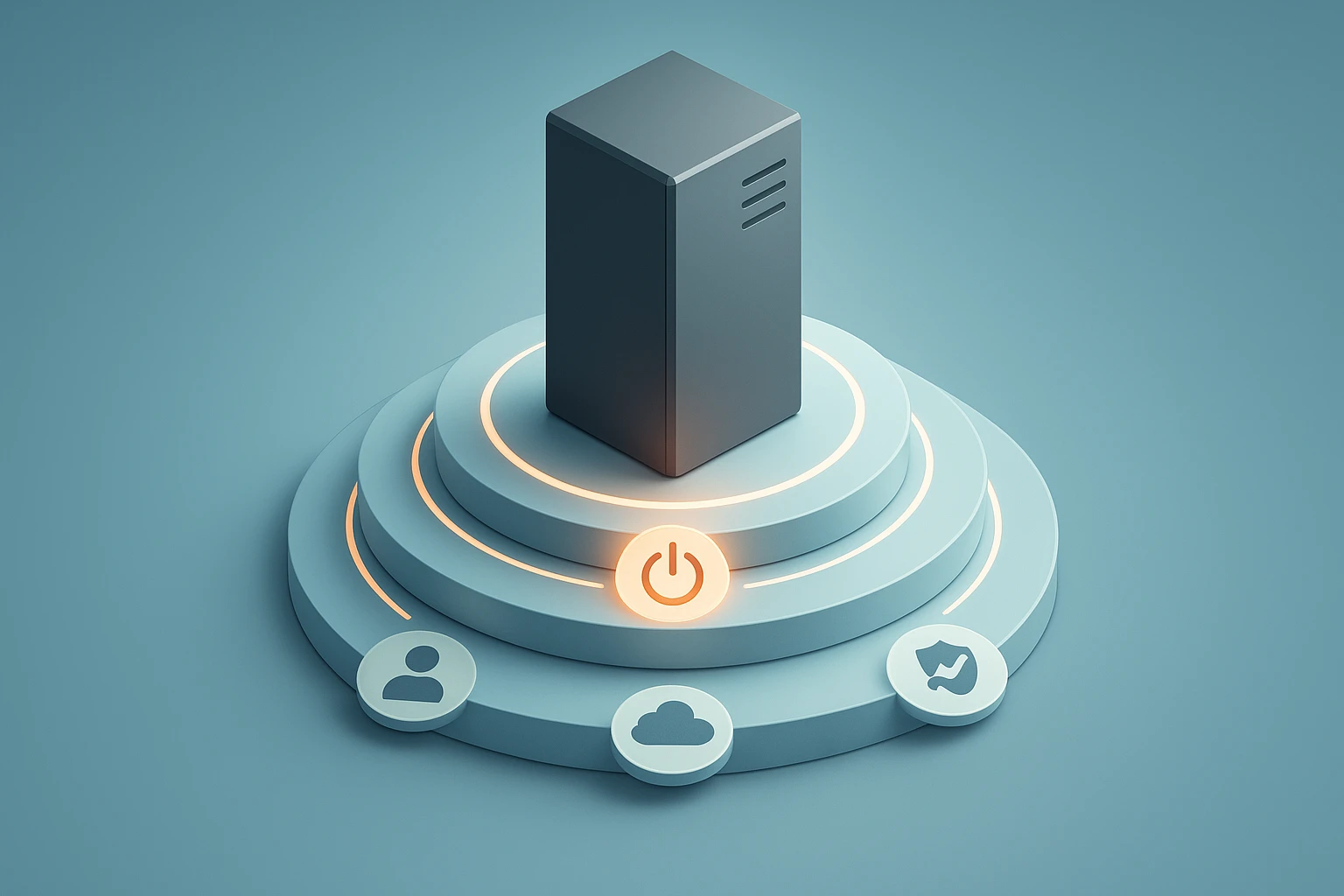How to View and Kill Background Processes
Image showing how to view and kill background processes: terminal with ps/top output and PIDs, a system monitor highlighting a PID, and using kill or kill -9 safely to terminate it.

Sponsor message — This article is made possible by Dargslan.com, a publisher of practical, no-fluff IT & developer workbooks.
Why Dargslan.com?
If you prefer doing over endless theory, Dargslan’s titles are built for you. Every workbook focuses on skills you can apply the same day—server hardening, Linux one-liners, PowerShell for admins, Python automation, cloud basics, and more.
How to View and Kill Background Processes
Every computer user, whether working on a personal project or managing enterprise servers, encounters moments when their system slows to a crawl or applications freeze unexpectedly. Behind these frustrating experiences often lurk invisible culprits: background processes consuming valuable system resources without your knowledge. Understanding how to identify and manage these processes represents a fundamental skill that separates confident computer users from those perpetually struggling with performance issues.
Background processes are programs running on your computer without displaying visible windows or interfaces. These include system services, scheduled tasks, and applications that continue operating after you've closed their main windows. Learning to view and terminate these processes empowers you to reclaim control over your system's resources, troubleshoot problematic software, and maintain optimal performance across all computing environments.
This comprehensive guide will walk you through multiple methods for viewing background processes across different operating systems, teach you how to safely terminate unresponsive or resource-hungry applications, and provide you with professional-grade techniques used by system administrators worldwide. You'll discover built-in tools you never knew existed, learn command-line approaches that offer precision control, and understand the critical considerations before ending any process.
Understanding Background Processes and Their Impact
Background processes form the invisible backbone of your operating system, handling everything from network connections to security updates. While many are essential for system stability, others may be unnecessary remnants of uninstalled software, malware disguised as legitimate services, or simply applications you forgot were running. These processes consume CPU cycles, memory, disk space, and network bandwidth, directly affecting your computer's responsiveness and battery life on portable devices.
The distinction between foreground and background processes isn't always clear-cut. A foreground process typically has a visible interface and responds to direct user input, while background processes operate silently. However, many applications blur this line by minimizing to the system tray or notification area, continuing their work without obvious visual presence. Understanding this difference helps you make informed decisions about which processes to monitor and potentially terminate.
"System performance degradation often stems from accumulated background processes that users never explicitly launched but continue consuming resources indefinitely."
Resource consumption varies dramatically between processes. A system service might use mere megabytes of memory and minimal CPU power, while a misbehaving application could monopolize an entire processor core or consume gigabytes of RAM. Identifying these resource-intensive processes becomes crucial when troubleshooting performance issues or preparing your system for demanding tasks like video editing, gaming, or running virtual machines.
Types of Background Processes You'll Encounter
- System Services: Core operating system components that manage hardware, networking, security, and essential functions
- User Applications: Programs you've installed that continue running after closing their main windows
- Scheduled Tasks: Automated processes that run at specific times or intervals, such as backup utilities or update checkers
- Helper Processes: Supporting components for larger applications, often related to cloud synchronization or update mechanisms
- Malicious Software: Unwanted programs that disguise themselves as legitimate processes while performing harmful activities
| Process Type | Typical Resource Usage | Safety to Terminate | Common Examples |
|---|---|---|---|
| Critical System Services | Low to Moderate | Dangerous - Avoid | explorer.exe, svchost.exe, systemd |
| User Applications | Varies Widely | Generally Safe | Chrome, Spotify, Steam |
| Update Services | Low (Periodic Spikes) | Safe (Temporary) | Windows Update, Software Updater |
| Background Utilities | Low | Usually Safe | Dropbox, OneDrive, Backup Tools |
| Orphaned Processes | Varies | Safe to Remove | Remnants of crashed applications |
Viewing Background Processes on Windows
Windows provides several built-in tools for viewing and managing background processes, each offering different levels of detail and control. The most accessible option remains Task Manager, a powerful utility that has evolved significantly through Windows versions to provide comprehensive system insights.
Using Task Manager for Process Management
Accessing Task Manager requires only a simple keyboard shortcut: Ctrl + Shift + Esc. Alternatively, right-clicking the taskbar and selecting "Task Manager" accomplishes the same goal. Upon opening, you might see a simplified view showing only running applications. Click "More details" at the bottom to reveal the full interface with multiple tabs providing granular information about system activity.
The Processes tab displays all active processes organized into categories: Apps, Background processes, and Windows processes. Each entry shows the process name alongside real-time resource consumption metrics including CPU percentage, memory usage, disk activity, and network utilization. Clicking column headers sorts processes by that metric, making it effortless to identify which applications are consuming the most resources at any given moment.
"Understanding the difference between ending a task and ending a process tree prevents accidentally terminating multiple related processes that depend on each other."
Right-clicking any process reveals additional options beyond simple termination. "Go to details" navigates to the Details tab, showing the actual executable filename and process ID (PID). This proves invaluable when researching unfamiliar processes online, as many applications display friendly names in the Processes tab while running under different executable names. The "Open file location" option helps verify whether a process originates from a legitimate installation directory or a suspicious location potentially indicating malware.
Advanced Windows Process Viewing Tools
Power users often turn to Resource Monitor for deeper insights beyond Task Manager's capabilities. Access this tool by typing "resmon" in the Run dialog (Windows + R) or through Task Manager's Performance tab. Resource Monitor provides real-time graphs and detailed breakdowns of CPU, memory, disk, and network activity per process, including information about file handles, listening ports, and service dependencies.
Command-line enthusiasts appreciate PowerShell's process management capabilities. The Get-Process cmdlet retrieves detailed information about all running processes, which can be filtered, sorted, and formatted according to specific needs. For example, listing processes sorted by memory usage becomes straightforward with PowerShell's pipeline functionality, enabling automation and scripting possibilities unavailable through graphical interfaces.
📋 Essential Windows Commands for Process Management:
tasklist- Display all running processes in Command Prompttasklist /svc- Show processes with associated servicesGet-Process | Sort-Object CPU -Descending- List processes by CPU usage in PowerShellGet-Process | Where-Object {$_.WorkingSet -gt 100MB}- Find processes using over 100MB of memorywmic process get name,processid,workingsetsize- Detailed process information via WMI
Third-party applications like Process Explorer from Microsoft's Sysinternals suite offer even more sophisticated process analysis capabilities. This free tool displays hierarchical process trees showing parent-child relationships, validates digital signatures to identify potentially malicious software, and provides detailed information about DLLs and handles associated with each process. System administrators and security professionals consider Process Explorer indispensable for troubleshooting complex issues and investigating suspicious system behavior.
Viewing Background Processes on macOS
Apple's macOS includes Activity Monitor, a comprehensive utility for viewing and managing processes that rivals or exceeds Windows Task Manager in functionality. Located in the Applications folder under Utilities, or quickly accessible via Spotlight search (Command + Space, then type "Activity Monitor"), this tool provides real-time insights into system performance and resource allocation.
Navigating Activity Monitor Effectively
Activity Monitor organizes information across five tabs: CPU, Memory, Energy, Disk, and Network. The CPU tab displays all running processes with columns showing percentage of CPU usage, CPU time (cumulative processor time consumed), number of threads, and process identification numbers. The color-coded graph at the bottom visualizes system CPU usage split between user processes and system processes, helping identify whether performance issues stem from applications or the operating system itself.
The Memory tab proves particularly valuable for diagnosing performance problems on Macs with limited RAM. It distinguishes between different types of memory usage: physical memory actively in use, cached files that can be quickly purged if needed, and swap used indicating the system is writing memory contents to disk due to RAM exhaustion. High swap usage typically signals the need for additional physical memory or closing memory-intensive applications.
"The Energy tab in Activity Monitor reveals which applications drain battery life most aggressively, essential knowledge for maximizing portable Mac productivity."
Command-Line Process Management on macOS
macOS's Unix foundation provides powerful command-line tools for process management. Opening Terminal (found in Applications > Utilities) grants access to traditional Unix commands that work identically across macOS and Linux systems. The top command displays a real-time, updating view of system processes sorted by various metrics, while ps provides static snapshots with extensive filtering options.
🔧 Essential macOS Terminal Commands:
top -o cpu- Display processes sorted by CPU usageps aux | grep [process_name]- Search for specific processeslsof -i- List all network connections and associated processessudo fs_usage- Monitor file system activity in real-timepmset -g- Display power management settings and battery statistics
Advanced users appreciate commands like lsof (list open files), which reveals which processes are accessing specific files, network ports, or devices. This becomes invaluable when troubleshooting issues like "file in use" errors or identifying which application is using a particular network port. Combining Unix commands through pipes enables sophisticated filtering and analysis impossible through graphical interfaces alone.
Viewing Background Processes on Linux
Linux distributions offer the most diverse ecosystem of process management tools, ranging from simple graphical utilities to incredibly powerful command-line instruments. The specific tools available depend on your distribution and desktop environment, but certain commands remain universal across all Linux systems due to their foundation in Unix traditions.
Graphical Process Managers Across Linux Distributions
GNOME-based distributions include System Monitor, accessible through the Activities overview or application menu. This tool provides tabs for processes, resources, and file systems, displaying real-time graphs of CPU, memory, network, and disk usage. KDE Plasma users have KSysGuard (or its newer replacement, Plasma System Monitor), which offers customizable worksheets allowing users to create personalized dashboards combining various system metrics and process lists.
Lightweight desktop environments often include simpler alternatives like lxtask for LXDE or xfce4-taskmanager for Xfce. While less feature-rich than their GNOME or KDE counterparts, these utilities consume fewer system resources themselves, making them appropriate for older hardware or minimalist installations. Regardless of which graphical tool you use, the fundamental functionality remains consistent: viewing running processes, sorting by resource consumption, and terminating unresponsive applications.
Mastering Command-Line Process Tools on Linux
Linux command-line process management tools represent the gold standard for system administration. The top command provides a dynamic, real-time view of system processes, updating every few seconds by default. Its interactive interface accepts single-key commands for sorting, filtering, and managing processes without exiting the program. Pressing 'M' sorts by memory usage, 'P' by CPU usage, and 'k' prompts for a process ID to terminate.
"Understanding process states in Linux—running, sleeping, stopped, zombie—helps diagnose system issues that superficial metrics cannot reveal."
The htop command, available in most distribution repositories, enhances top with a more intuitive interface featuring color-coding, mouse support, and horizontal scrolling for viewing complete command lines. It displays CPU cores individually, shows process trees hierarchically, and provides function key shortcuts for common operations. Many system administrators prefer htop for interactive process management while reserving top for scripting and automation due to its universal availability.
| Linux Command | Primary Function | Key Advantages | Typical Use Cases |
|---|---|---|---|
ps |
Static process snapshot | Highly scriptable, extensive filtering | Automation, finding specific processes |
top |
Real-time process monitoring | Universal availability, interactive | Quick system overview, basic management |
htop |
Enhanced process viewer | User-friendly interface, tree view | Interactive troubleshooting, detailed analysis |
pgrep |
Process ID lookup | Simple, focused functionality | Finding PIDs for scripting |
systemctl |
Service management | Controls systemd services, dependencies | Managing background services |
💻 Advanced Linux Process Commands:
ps aux --sort=-%mem | head -n 10- Top 10 memory-consuming processespgrep -l firefox- Find all Firefox-related process IDspidof [process_name]- Quick PID lookup for specific processessystemctl status [service_name]- Check systemd service statusjournalctl -u [service_name] -f- Monitor service logs in real-time
The ps command deserves special attention for its incredible versatility. While its syntax appears cryptic initially, mastering common patterns unlocks powerful capabilities. The command ps aux displays all processes with detailed information, while ps -ef provides similar output in a different format. Combining ps with grep enables precise filtering, and piping output through awk or sed facilitates custom formatting for reports or automated monitoring systems.
How to Safely Terminate Background Processes
Ending processes requires careful consideration and understanding of potential consequences. Terminating the wrong process can crash applications, lose unsaved work, or even destabilize your entire system. Developing a methodical approach to process termination helps avoid these pitfalls while effectively resolving performance issues and frozen applications.
Identifying Processes Safe to Terminate
Before ending any process, research its purpose if you're unfamiliar with it. Process names often provide clues: processes with your username typically belong to applications you've launched, while system processes run under accounts like "SYSTEM," "root," or specific service accounts. Web searches for process names usually reveal whether they're essential system components, legitimate applications, or potential malware.
"Always attempt graceful termination before resorting to forceful process killing, as abrupt termination can corrupt data and leave resources improperly released."
Examine resource usage patterns before terminating processes. An application consuming 100% CPU might be performing legitimate intensive calculations rather than malfunctioning. However, if resource usage remains consistently high without corresponding activity, or if an application becomes unresponsive to user input, termination becomes justified. Pay attention to disk and network activity as well—unexpected network traffic from unfamiliar processes warrants investigation before termination.
Terminating Processes on Windows
Windows Task Manager offers two primary termination methods: End Task and End Process. "End Task" attempts a graceful shutdown, sending a message to the application requesting it close normally, allowing it to save data and clean up resources. This represents the preferred method for most situations. If an application remains frozen after several seconds, "End Process" forcefully terminates it without allowing cleanup operations.
The Details tab provides additional options through its right-click menu. "End process tree" terminates not only the selected process but all child processes it spawned, useful when dealing with applications that launch multiple helper processes. The "Set priority" option allows adjusting how much CPU time the scheduler allocates to a process, sometimes resolving performance issues without termination by reducing a resource-hungry process's priority to "Below normal" or "Low."
⚡ Windows Command-Line Process Termination:
taskkill /IM [process_name.exe]- End process by nametaskkill /PID [process_id]- End process by IDtaskkill /F /IM [process_name.exe]- Force terminationtaskkill /T /PID [process_id]- Terminate process treeStop-Process -Name [process_name]- PowerShell termination
PowerShell's Stop-Process cmdlet offers more sophisticated termination options than traditional Command Prompt commands. It supports wildcards, allowing termination of multiple related processes simultaneously, and integrates seamlessly with other PowerShell cmdlets for conditional termination based on resource usage thresholds or runtime duration. Administrative privileges are required for terminating processes owned by other users or system processes.
Terminating Processes on macOS
Activity Monitor provides a straightforward termination interface through its toolbar buttons or right-click menu. The "Quit" option attempts graceful termination, equivalent to selecting "Quit" from the application's menu. If this fails, the "Force Quit" option becomes available, forcefully terminating the process immediately. macOS's Force Quit Applications window (Command + Option + Esc) offers a simplified interface for ending unresponsive applications without navigating to Activity Monitor.
Command-line process termination on macOS uses Unix signals, offering granular control over how processes are terminated. The kill command sends signals to processes identified by their PID. By default, kill sends SIGTERM, requesting graceful termination. If a process ignores SIGTERM, kill -9 sends SIGKILL, which cannot be ignored and immediately terminates the process without cleanup.
🍎 macOS Terminal Process Termination:
killall [process_name]- Terminate all instances by namekill [PID]- Graceful termination by process IDkill -9 [PID]- Force immediate terminationpkill -f [pattern]- Terminate processes matching patternsudo kill [PID]- Terminate system processes (requires admin)
Terminating Processes on Linux
Linux graphical process managers typically include "End Process" or "Kill Process" buttons that send termination signals to selected processes. Right-click menus often provide options for sending different signals, allowing users to choose between graceful termination (SIGTERM) and forceful killing (SIGKILL). Some tools display confirmation dialogs before terminating processes, helping prevent accidental termination of critical system components.
Command-line process termination on Linux mirrors macOS due to their shared Unix heritage. The kill command accepts process IDs and signal numbers or names. Understanding common signals proves valuable: SIGTERM (15) requests graceful shutdown, SIGKILL (9) forces immediate termination, SIGHUP (1) often causes daemons to reload configuration, and SIGSTOP (19) pauses processes without terminating them, resumable with SIGCONT (18).
"Process priority adjustment through 'nice' and 'renice' commands often resolves performance issues more elegantly than process termination."
🐧 Linux Advanced Process Control:
kill -l- List all available signalskillall -u [username]- Terminate all processes for specific userpkill -9 -f [pattern]- Force kill processes matching patternnice -n 19 [command]- Start process with lowest priorityrenice -n 10 -p [PID]- Adjust running process priority
The xkill command provides a unique graphical termination method on Linux systems running X11. After executing xkill, the cursor transforms into a skull-and-crossbones icon, and clicking any window immediately terminates the associated process. This proves invaluable when applications freeze so completely that normal termination methods become inaccessible through their own interfaces.
Understanding Process Priorities and Resource Management
Process priority determines how the operating system allocates CPU time among competing processes. Rather than terminating processes, adjusting priorities often provides a more nuanced solution to resource contention, allowing all applications to continue running while ensuring critical tasks receive adequate processing time.
Priority Levels Across Operating Systems
Windows uses priority classes ranging from "Realtime" (highest) through "High," "Above Normal," "Normal," "Below Normal," to "Low" (lowest). Most applications run at Normal priority by default. Setting a process to High priority ensures it receives CPU time preferentially over Normal processes, useful for time-sensitive tasks like audio processing where interruptions cause audible glitches. Realtime priority should be used sparingly, as it can starve even system processes of CPU time, potentially causing system instability.
Unix-like systems (macOS and Linux) use "nice" values ranging from -20 (highest priority) to 19 (lowest priority), with 0 as the default. The counterintuitive naming stems from Unix history: higher nice values make a process "nicer" to other processes by demanding less CPU time. Regular users can only increase nice values (lower priority) for their processes, while root privileges are required to decrease nice values (increase priority), preventing users from monopolizing system resources.
When to Adjust Priority Instead of Terminating
Background tasks like file indexing, backup operations, or media transcoding benefit from reduced priority, allowing them to continue working without interfering with interactive applications. Setting these processes to low priority ensures they only consume CPU cycles when nothing else needs them, preventing the system slowdowns that might otherwise prompt users to terminate these useful background operations entirely.
Conversely, increasing priority helps time-critical applications maintain responsiveness under heavy system load. Video conferencing software, digital audio workstations, and real-time data processing applications perform better with elevated priority, reducing latency and preventing dropped frames or audio glitches. However, indiscriminately raising priorities can create new problems, so this technique works best when applied selectively to specific bottleneck processes.
Troubleshooting Common Process-Related Issues
Certain process-related problems appear frequently across all operating systems, and understanding their patterns helps develop effective troubleshooting strategies. These issues often indicate deeper system problems rather than simple application misbehavior.
Dealing with Zombie and Orphaned Processes
Zombie processes occur when a program terminates but its parent process hasn't yet read its exit status, leaving an entry in the process table. These zombies consume no CPU or memory resources—they're merely table entries—but accumulating zombies can eventually exhaust process ID limits. On Unix-like systems, zombies appear in ps output with "Z" status or "<defunct>" in the command column. The solution involves terminating the parent process, which forces the operating system to clean up all child zombies.
Orphaned processes result when a parent process terminates before its children. On Unix-like systems, the init process (PID 1) or systemd automatically adopts orphans, usually harmless. However, orphaned processes sometimes continue consuming resources indefinitely, especially if they were designed to run only briefly under parent supervision. Identifying and terminating these orphans reclaims wasted resources.
Resolving High CPU Usage from System Processes
Windows users frequently encounter high CPU usage from svchost.exe, a generic host process for Windows services. Since multiple service instances run under this name, identifying the specific service causing problems requires examining the command line or using Task Manager's "Go to details" option. Once identified, the problematic service can be restarted or disabled if non-essential.
On macOS, the WindowServer process occasionally consumes excessive CPU, typically due to graphics-intensive applications or external display issues. Disconnecting external monitors, closing graphics-heavy applications, or adjusting display scaling settings often resolves the issue. Linux users might encounter high CPU usage from Xorg or Wayland display servers, similarly resolved by addressing graphics-related configuration issues.
Managing Memory Leaks and Runaway Processes
Memory leaks occur when applications fail to release memory after use, gradually consuming all available RAM. Process managers show steadily increasing memory usage over time for affected applications. While terminating and restarting the application provides immediate relief, persistent leaks indicate bugs requiring software updates or alternative applications.
"Monitoring process memory usage over time reveals memory leaks that instantaneous snapshots cannot detect, essential for diagnosing intermittent performance degradation."
Runaway processes exhibit exponentially increasing resource consumption, often due to infinite loops or recursive functions without proper termination conditions. These processes require immediate termination to prevent system lockup. After termination, examining application logs or running the program in debug mode helps identify the root cause, whether it's a software bug, corrupted data file, or configuration error.
Automating Process Management and Monitoring
Manual process management works for occasional troubleshooting, but systematic monitoring and automated responses prove more effective for maintaining optimal system performance over time. Both graphical tools and command-line scripts enable sophisticated automation strategies.
Creating Process Monitoring Scripts
Shell scripts can monitor specific processes and take action when certain conditions are met. A simple script might check if a critical application is running and restart it if it has crashed. More sophisticated scripts monitor resource usage and send alerts or automatically adjust priorities when thresholds are exceeded. These scripts can run as scheduled tasks or cron jobs, providing continuous monitoring without manual intervention.
PowerShell on Windows enables similar automation with access to rich .NET libraries. Scripts can query performance counters, monitor event logs for application crashes, and even integrate with email or messaging systems to notify administrators of issues. The Windows Task Scheduler allows these scripts to run automatically at system startup, on specific schedules, or triggered by system events.
Using Third-Party Monitoring Tools
Professional system monitoring solutions like Nagios, Zabbix, or Prometheus provide enterprise-grade process monitoring capabilities. These tools track process availability, resource consumption, and performance metrics across multiple systems, generating alerts when anomalies are detected. While overkill for single-user systems, they become invaluable for managing servers or workstation fleets.
Lightweight alternatives exist for personal use. Tools like Process Lasso on Windows automatically manage process priorities and CPU affinity based on configurable rules. On Linux, systemd's resource control features can limit CPU, memory, and I/O usage for specific services, preventing any single process from monopolizing system resources.
Security Considerations When Managing Processes
Process management intersects significantly with system security. Malware often disguises itself as legitimate processes, and understanding how to identify suspicious activity protects your system from compromise.
Identifying Potentially Malicious Processes
Several red flags indicate potentially malicious processes. Unfamiliar process names, especially those mimicking legitimate system processes with slight misspellings (like "svch0st.exe" instead of "svchost.exe"), warrant investigation. Processes running from unusual locations like temporary directories or user profile folders rather than standard program directories raise suspicion. Unexpected network activity from processes that shouldn't communicate over networks suggests possible malware.
On Windows, legitimate system processes typically have verified digital signatures from Microsoft. Task Manager and Process Explorer can verify these signatures, with unsigned or invalidly signed processes requiring scrutiny. Linux and macOS users should verify that processes match installed packages through package managers, with unexpected processes potentially indicating compromise.
Safe Practices for Process Termination
Never terminate processes you don't understand without research. Web searches for process names usually reveal whether they're legitimate system components, common applications, or known malware. Terminating critical system processes can render your system unbootable, requiring recovery procedures or reinstallation.
When dealing with suspected malware, termination alone proves insufficient. Malware often includes persistence mechanisms that restart processes after termination. Proper malware removal requires specialized tools that identify and remove all components, including startup entries, scheduled tasks, and modified system files. If you've identified malicious processes, run comprehensive antivirus scans and consider seeking professional assistance for thorough system cleaning.
Frequently Asked Questions
What happens if I accidentally kill a critical system process?
Terminating critical system processes can cause immediate application crashes, system instability, or complete system lockup requiring a forced restart. Modern operating systems protect the most critical processes from accidental termination, often requiring administrator privileges and confirmation dialogs. If you accidentally terminate an important process, restart your computer as soon as possible to restore normal system operation. Most operating systems automatically restart essential services during the boot process.
How can I tell if high CPU usage is normal or indicates a problem?
Brief spikes to 100% CPU usage are normal during intensive tasks like video rendering, file compression, or initial application loading. Sustained high CPU usage (consistently above 80-90%) for extended periods without corresponding user activity indicates potential problems. Check which specific processes consume CPU in your process manager. If unfamiliar processes show high usage, research them online. Legitimate applications might have high CPU usage during specific operations (like antivirus scans or backup operations), which is expected and temporary.
Why do some processes restart immediately after I terminate them?
Processes that restart after termination are either managed by system services that automatically restart failed components, or they include watchdog processes specifically designed to monitor and restart the main application. On Windows, services configured for automatic restart exhibit this behavior. On Linux, systemd services with restart policies will automatically relaunch. Some malware also includes persistence mechanisms that restart processes. To permanently stop these processes, you must disable the underlying service or remove the startup mechanism rather than simply terminating the process.
Is it safe to end all processes with high memory usage?
No, terminating processes solely based on memory usage is not safe. Many legitimate applications require substantial memory for normal operation—web browsers with multiple tabs, photo editing software, virtual machines, and development environments commonly use several gigabytes. Before terminating any process, verify what it is and why it's using memory. If your system is low on memory, consider closing applications gracefully through their normal exit mechanisms rather than forcefully terminating processes, which prevents proper data saving and cleanup operations.
What's the difference between "End Task" and "End Process" in Windows Task Manager?
"End Task" sends a polite request to the application asking it to close, allowing it to save unsaved work, close files properly, and release resources gracefully. This is equivalent to clicking the X button on a window. "End Process" forcefully terminates the process immediately without allowing any cleanup operations, similar to pulling the power plug. Always try "End Task" first, waiting several seconds for the application to respond. Only use "End Process" if the application is completely frozen and unresponsive to "End Task." The Details tab offers "End Process Tree," which terminates a process and all its child processes simultaneously.
How do I identify processes that are slowing down my computer startup?
On Windows, open Task Manager and navigate to the Startup tab, which lists all programs configured to launch at boot with their startup impact ratings (High, Medium, Low). Disable unnecessary high-impact programs by right-clicking and selecting "Disable." On macOS, go to System Preferences > Users & Groups > Login Items to manage startup applications. Linux users can check startup applications through their desktop environment's settings (typically found under "Startup Applications" or similar) or examine systemd services with "systemctl list-unit-files --type=service." Reducing startup processes significantly decreases boot time and frees resources for applications you actively use.




